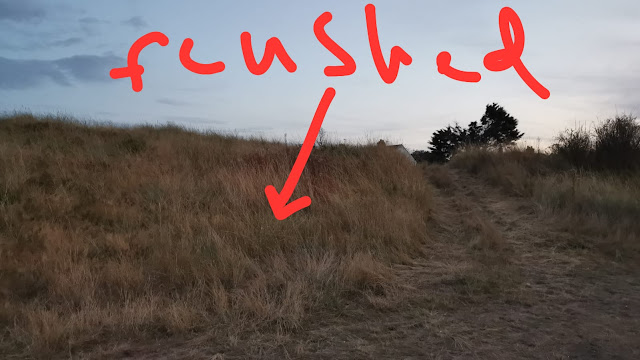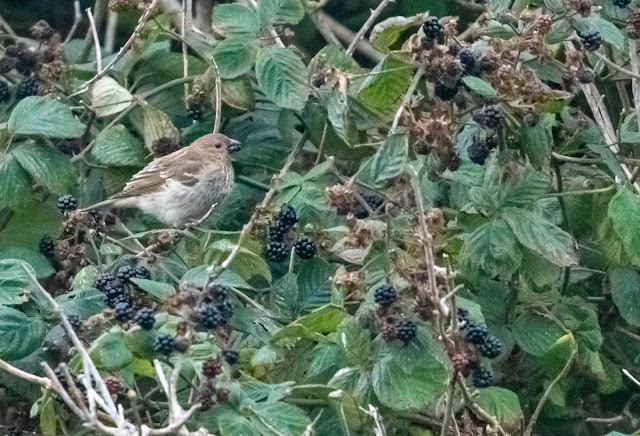September started with a bit of a bang. As most of us locals were pottering about seeing things like a Pied Flycatcher below the Hermanus, a Swift over the village, and brief views by Peter of a possible Wryneck near the Totem Pole Bushes, extraordinary news came out in the afternoon of a staggering haul by an unidentified birder:
Given that nobody seemed to know who the observer was, and the news was emerging over three hours after the observation, there was some degree of incredulity over these sightings, but nevertheless you never know unless you check, so several of us set off into the North Dunes to see for ourselves. Despite the somewhat easterly winds there wasn't a lot of activity - a few Wheatears on the dunes, but the bushes largely empty, and so we began to conclude that whoever had claimed such a bounty had been either having a hallucination or a laugh. But just when we were all on the verge of giving up another visiting birder did indeed locate (or relocate) a Red-breasted Flycatcher in a clump of bushes south of the East Pool, and Sean, who was closest, was able to get there within a few minutes and send this record shot out:
After a bit of a scramble several more of us and other birders were able to reach the spot and enjoy fleeting views as the lovely little flycatcher moved around in the clump. Tim came up with his big gun and got the best photo, as usual!
So one of the three species claimed by the mystery birder had proved to be true, but what of the other two? In the absence of more precise location details nobody was able to find a Barred Warbler, and a Pechora Pipit seemed just crazy! It would have been considerably earlier than any previous British record, and, even more incredibly, not in Shetland! It was just too much to believe. And yet...
And yet it turned out that the observer was credible and experienced, just not someone who enjoys being 'on the scene', and he gave a convincing description of the bird to another birder who knows him well, which included the all-important feature of the primaries peeping out beyond the tertials, which rules out pretty much anything else! He watched the bird for 40 minutes in the late morning before he had to leave for work, and although he sent news to another birder immediately, a combination of factors meant it didn't reach the information services until three hours later. We looked a lot that day and the next, but there was not a sign, and the solo observer didn't take any photos, and I'm not sure if the record will be submitted, but September had certainly started with a bang!
Alas the month did not continue in this vein. Despite a decent easterly airstream in the following few days, it was such thin pickings.
Mick found a Purple Sandpiper on the 2nd, and over the following days there were a few Whinchats, a few Redstarts, and double figures of Wheatears . Maynard did a seawatch on the 2nd and had Sooty Shearwater, Bonxie, Arctic Skua and Great Crested Grebe. A few Hobbies were around and a visiting birder had a Grey Partridge in the North Dunes, so presumably the estate had begun to release a few in readiness for the landed gentry to enjoy murdering them in the coming weeks. A few Swifts were still about too, but for the first week in September, with the wind in the east, it was, as one of our neighbouring birders just to the north of us put it, "desperate, desperate stuff".
On the 5th Sean was tramping through long grass in the North Dunes looking for Pechora Pipits when he flushed up presumably the same Grey Partridge as a few days earlier. He brazenly claimed that it was "extremely wary and obviously wild", just so he could add it to his year list. There were public jibes from various quarters within the Collective, followed up by private messages asking for the exact location...
Whinchat numbers in the North Dunes reached double figures on the 5th, and on the 6th there were around 200 Mediterranean Gulls over the village mid-morning.
Into the second week commoner warblers passed through in small numbers, including a few Lesser Whitethroats and Garden Warblers, and one Sedge Warbler. On the 8th the resident Hybrid Hooded Crow was joined by another in the South Dunes, and, in a clear display of avian fascism, both were rounded upon viciously by a group of pure-bred Carrion Crows. A Red Kite went south through the North Dunes.
Mick had a Goldcrest at the Plantation on the 9th, and on the 10th Sean had a calling flyover Tree Pipit in the South Dunes, plus Siskin and Cuckoo. The regular Autumn movement of Great Spotted Woodpeckers also got underway, with two flyovers south. On the 11th Pat had a flyover Grey Wagtail in the South Dunes, Sean a Spotted Flycatcher at the Oaks and Pete another flyover Red Kite circling low near the Totem Pole. In the evening there were quite a few Sandwich Terns around, and a close Arctic Skua getting its supper from them.
Around this time in the month we began to notice Guillemots close to shore, like this one which was calling plaintively in the surf.
It quickly emerged that Guillemots were in trouble right up and down the east coast, and we saw increasing numbers along the shore, sadly including quite a few corpses on the beach. However lots of them seemed to be fishing successfully despite being so close in, so hopefully they’ll make it.
On the evening of the 11th Sean flushed the Grey Partridge yet again and sent out highly detailed directions for the champing Collective yearlisters 😁.
As the middle of the month approach it was difficult to keep spirits up. The patch was dead, despite some light easterly breezes. There was no vismig going on, and the Whinchats had departed. Attention turned largely to the sea, where Sooty Shearwaters and Bonxies passed in tiny numbers. A fairly decent duck movement on the 15th included a few Pintails, and a Redstart and Cuckoo on the same date were new arrivals.
On the 16th Sean went through the South Dunes in the morning and noticed a considerable increase in Phylloscs in the valley, which was encouraging. He messaged Barry and noted "Nothing rare but lots more birds". However, Barry was shortly going to tell him that he'd lied, because later in the morning Colin also took a walk through and found something he wasn't sure about... Mick arrived within a few minutes and was able to confirm that Colin had found himself a juvenile Common Rosefinch! For posterity, here is the first picture Mick sent out of it:
Luckily the bird stayed for everyone to catch up with it and more photos and even video were taken. Here is a selection:
A great find and a continuation of Colin's good year...
Hirundines started moving in numbers from around the middle of the month, with a very large flock of House Martins and some Swallows moving south on the 17th, and around this time the resident Tawny Owls on the western edge of the village were making themselves heard (and seen) more frequently.
The next day Patrick had a close Manx Shearwater south (they've been extremely rare this year) and Sean had three Pintails going north.






















0 comments:
Post a Comment